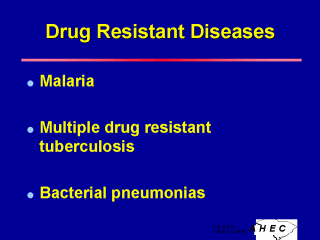| front |1 |2 |3 |4 |5 |6 |7 |8 |9 |10 |11 |12 |13 |14 |15 |16 |17 |18 |19 |20 |21 |22 |23 |24 |25 |26 |27 |28 |29 |30 |31 |32 |33 |34 |35 |review |
 |
There is great concern that common bacterial pathogens (I.e. TB, malaria, Shigella, Salmonella, Streptococcus, Pneumococcus) have become resistant to many of the antibiotics commonly used in the past 20 years. The increase in drug resistance has resulted from several practices, including inappropriate use (prescribing an antibiotic for a viral episode), over-prescribing, poor patient compliance in completing entire treatment series, and the widespread use of antiseptics. A 1995 US government report estimated that the emergence of antimicrobial resistance among six common bacteria in hospitals added $661 million per year in hospital charges. Resistance to antimalarial drugs is widespread worldwide. For many years, chloroquine was the mainstay of treatment, but resistant strains have spread and intensified in all malaria endemic areas. There is also concern over multidrug resistant TB with an occasional “Godzilla strain” unresponsive to any current antibiotic. The CDC has established the National Tuberculosis Genotyping and Surveillance Network to track strains of drug resistant TB. USDHHS (1998). Preventing Emerging Infectious Diseases: A Strategy for the 21st Century, Atlanta: Centers for Disease Control and Prevention. US Congress Office of Technology Assessment (1995). Impacts of antibiotic-resistant bacteria [OTA-H-629]. Washington DC: US Government Printing Office. |
| front |1 |2 |3 |4 |5 |6 |7 |8 |9 |10 |11 |12 |13 |14 |15 |16 |17 |18 |19 |20 |21 |22 |23 |24 |25 |26 |27 |28 |29 |30 |31 |32 |33 |34 |35 |review |